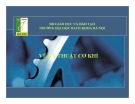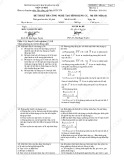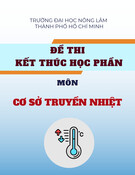
REVIEW ARTICLE
Nuclear data research supported by EURATOM: CHANDA,
ERINDA and EUFRAT
Enrique Miguel Gonzalez
1,*
, Arnd Rudolf Junghans
2
, Arjan Plompen
3
, and Peter Schillebeeckx
3
1
Centro de Investigaciones Energéticas, Medioambientales y Tecnológicas (CIEMAT), Avda. Complutense, 40, 28040 Madrid,
Spain
2
Helmholtz-Zentrum Dresden Rossendorf (HZDR), Bautzner Landstr. 400, 01328 Dresden, Germany
3
Joint Research Centre (JRC), Retieseweg 111, 2440 Geel, Belgium
Received: 12 March 2019 / Accepted: 4 June 2019
Abstract. Nuclear data and associated tools are critical elements of the nuclear energy industry and research,
playing an essential role in the simulation of nuclear systems, safety and performance calculations and
interpretation of the reactor instrumentation. Nuclear data improvement requires a combination of much
different know-hows that are distributed over many small- and medium-sized institutions along Europe. The
Euratom programs have facilitated the setup of pan European collaborations getting together the required
experience inside the projects CHANDA, ERINDA and the JRC action EUFRAT. The paper describes the
holistic and inclusive approach of these projects that have also worked together to coordinate the European
nuclear data research capabilities to improve the facilities, detectors, models and evaluation, validation and
simulation tools. It also shows examples of success histories and summary of results of these projects and of their
impact on the EU nuclear safety and industry, together with an outlook to the future.
1 Introduction
Nuclear data and associated tools are a critical element of
the nuclear energy industry and research. They play an
essential role in the simulation of nuclear systems or devices
for nuclear energy and non-energy applications, for the
calculation of safety and performance parameters of
existing and future reactors and other nuclear facilities,
for the innovation of the design of those nuclear facilities
and the innovation on radioactive devices and use of
radioactive materials in non-energy applications, and for
the interpretation of measurements in these facilities and
systems.
Nuclear data, ND, is often not visible for applications
that rely on the huge data sets of nuclear cross sections,
emission probabilities, branching ratios, atomic masses, life
times, energy levels, fission yields and many other nuclear
data. However, with the present computing power and the
development of the simulation codes, in many cases the
limiting factor for the accuracy and prediction capabilities
of these simulation codes comes from the accuracy of the
relevant nuclear data and their uncertainties. Indeed, no
matter how sophisticated the tool is, no simulation,
calculation or interpretation of measurements can be
better than the limit imposed by the nuclear data they use.
For these reasons, there are continuous request of new
or better nuclear data, coming from new levels of safety,
new safety criteria and scenarios, new reactor designs or
new applications or new modes of operations of present
reactors, innovative solutions for waste management and
from pending requests, not feasible in the past, that can be
addressed with the present R&D on nuclear data and tools.
These requests are regularly evaluated and maintained in
high-priority request lists, in the framework of interna-
tional initiatives and international organisation like IAEA
and NEA/OECD.
In order to have nuclear data available to applications,
several steps are needed in what is known as the nuclear
data cycle. Nuclear data are typically deduced from
differential (microscopic) measurements (a more or less
direct measurement of the reaction of interest separated
from other effects). This requires preparation of a high
purity sample of the nuclide to measure, often radioactive
and scarce, as well as the availability of sophisticated
detection systems and controllable sources of neutrons and
other radiations (often based on particle accelerators).
Then the data are analyzed and the results are provided to
international databases. Putting together results of several
measurements and using nuclear theories, the data are
*e-mail: enrique.gonzalez@ciemat.es
EPJ Nuclear Sci. Technol. 6, 30 (2020)
©E.M. Gonzalez et al., published by EDP Sciences, 2020
https://doi.org/10.1051/epjn/2019024
Nuclear
Sciences
& Technologies
Available online at:
https://www.epj-n.org
This is an Open Access article distributed under the terms of the Creative Commons Attribution License (http://creativecommons.org/licenses/by/4.0),
which permits unrestricted use, distribution, and reproduction in any medium, provided the original work is properly cited.

further analyzed, and finally assembled into what is known
as “evaluated nuclear data libraries”. These evaluated data
are then validated by comparing their predictions to
integral experiments (complex systems, typically experi-
mental reactors). From the differences between predictions
and integral experiments, we can deduce corrections to the
basic nuclear data and develop better evaluated libraries.
This validation process can also reveal a possible need for
additional differential measurements or evaluations, re-
peating the process until the required accuracy is achieved.
As a consequence, producing high quality data requires
a combination of much different know-hows (target
production, detectors, neutron sources, analysis, evalua-
tion, nuclear theory, nuclear reactors, simulation codes,
and others). In addition, it is important to realize that the
necessary expert know-how is widely distributed within
many research teams, particularly in Europe, and that
most of these teams specialize only on one or few
components of the nuclear data cycle. Therefore, in order
to provide the nuclear data needed, it is important to
prepare a very well structured wide and well synchronized
collaboration between the key EU expert institutions.
The EURATOM framework program has been instru-
mental during the FP7 and before, to nucleate pan-
European collaborations of laboratories that on one side
have developed competitive projects to develop the tools
and perform measurements, evaluation and validation of
new or improved nuclear data like CHANDA. It has also
facilitated the setup of frameworks for easy and efficient
transnational access to experimental facilities needed for
those activities, like the competitive proposal ERINDA
and the direct JRC action EUFRAT.
1.1 ERINDA
The ERINDA project [1] (European Research Infra-
structures for Nuclear Data Applications) has coordinated
the European efforts to exploit up-to-date neutron beam
technology for novel research on advanced concepts for
nuclear fission reactors and the transmutation of radioac-
tive waste. For the development of these transmutation
systems and for improved nuclear safety, accurate nuclear
data haven been obtained in the ERINDA project. The
strategic objectives of ERINDA were:
–to provide transnational access for nuclear data measure-
ments at the consortium’s facilities;
–experiments should account for nuclear data requests of
highest priority and scientific value;
–improve simulation methods to predict the running
conditions of innovative reactor systems and the
transmutation of nuclear waste;
–generation of complete, accurate and consistent nuclear
data libraries and measured nuclear reaction cross-
sections.
ERINDA offered the nuclear data research infra-
structures of 13 partners (HZDR, JRC-GEEL, CERN,
CENBG, IPNO, UU-TSL, PTB, NPI, IKI, IFIN-HH, NPL,
FRANZ and CEA) from all over Europe to experimental
teams making new nuclear data measurements. The
ERINDA facilities included different neutron sources
and methods for nuclear data measurement, in particular:
–time of flight facilities for fast neutrons:
•nELBE (HZDR, Dresden); n_TOF (CERN, Geneva);
GELINA (JRC, Geel);
–charged-particle accelerators:
•production of quasi-monoenergetic neutrons electro-
static accelerators in Bordeaux, Orsay, Bucharest and
Dresden,
•neutron reference fields at PTB Braunschweig and
NPL Teddington,
•cyclotrons in Řež, Jyväskylä, Oslo and Uppsala with
neutron energy range up to 180 MeV,
•pulsed proton linear accelerator in Frankfurt;
–research reactors:
•Budapest and Řežcold neutron beam, Prompt Gamma
Activation Analysis.
Within the project 3015 additional hours of beam time
at the consortium facilities have been provided in 26
experiments as transnational-access including technical
and travel support for the user groups. In addition, 16 short
term visits (with a total duration of 106 weeks) of scientists
to the consortium institutes were supported. In this way
theoretical data analysis and computer simulations rele-
vant to the experiments were performed. All ERINDA
facilities were grouped in a pool. To optimize the scientific
output of the experiments, a Project Advisory Committee
(PAC) consisting of five external experts selected from the
submitted experiment proposals was made and decided
about the best suited facility for a certain type of
measurement. The transnational access budget was
distributed according to the PAC decisions. The partici-
pation of post-doctoral fellows and PhD students in all
ERINDA activities was especially encouraged.
Four European scientific meetings in Dresden, Prague,
Jyväskylä and Geneva were organized to communicate the
progress and disseminate the results of the ERINDA
project.
1.2 EUFRAT
Since 2005, JRC-Geel has a programme offering access to
its nuclear research infrastructure for external users. In the
period 2005–2012 the programme was running with
support from DG-RTD (indirect actions NUDAME and
EUFRAT). To transform it into a sustainable programme,
the open access runs since the beginning of 2014 as an
institutional project entitled “European Facilities for
Nuclear Reaction and Decay Data Measurements
(EUFRAT)”. In 2017, EUFRAT [2] was selected as a pilot
project to start a JRC-wide open access scheme that
includes nuclear and non-nuclear research infrastructures.
The JRC-Geel approach for open access to its nuclear
facilities has been copied for three other transnational
access projects in the nuclear data field that were supported
by DG-RTD, i.e. EFNUDAT, ERINDA and CHANDA.
The nuclear research facilities at JRC-Geel are designed
for the measurements of highly accurate neutron cross
section and nuclear decay data in support to nuclear energy
applications: safe operation of nuclear reactors, nuclear
safeguards, safe handling of nuclear waste and safe,
2 E.M. Gonzalez et al.: EPJ Nuclear Sci. Technol. 6, 30 (2020)

ecological and economical disposal of spent nuclear fuel.
They also serve the needs for non-energy applications:
production of medical radionuclides, the safety of citizen
and environment, environmental tracer studies to under-
stand climate change, new detector developments, nuclear
astrophysics, cultural heritage and materials research. The
nuclear infrastructure at JRC-Geel includes:
–the GELINA research infrastructure, which combines a
white neutron source produced by a 150 MeV linear
electron accelerator with a high-resolution neutron time-
of-flight facility;
–the MONNET research infrastructure for the production
of continuous and pulsed proton-, deuteron- and helium
ion beams is based on a 3.5 MV Tandem accelerator and
serves for the production of well-characterised quasi
mono-energetic neutrons. The tandem replaces the 7 MV
Van de Graaff (VdG) accelerator that was operated until
August 2015;
–the RADMET radionuclide metrology laboratories,
which are used for radioactivity measurements;
–an ultra low-level radioactivity laboratory, which is
hosted in the deep-underground facility HADES of the
SCK•CEN; and
–a laboratory for the preparation and characterisation
of samples and targets needed for nuclear data
measurements.
1.3 CHANDA
The CHANDA project [3] brought together the majority of
the European nuclear data community, infrastructures and
resources to prepare the methodologies, detectors, facili-
ties, interpretation models and tools to produce and use
nuclear data with the quality required to comply with the
needs for the safety standards that are mandatory for
present and future European nuclear reactors and other
installations using radioactive materials. Significant tech-
nical, methodological and organizational challenges have
previously prevented the achievement of this goal for a
number of relevant isotopes and nuclear reactions and
CHANDA has focused its effort on overcoming those
challenges.
CHANDA included 36 partners (CIEMAT,
ANSALDO, CCFE, CEA, CERN, CNRS, CSIC, ENEA,
GANIL, HZDR, IFIN-HH, INFN, IST-ID, JRC, JSI, JYU,
KFKI, NNL, NPI, NPL, NRG, NTUA, PSI, PTB, SCK,
TUW, UB, UFrank, UMainz, UMan, UPC, UPM, USC,
UU, UOslo, US) from 16 countries from EU plus
Switzerland and Norway and 18 of the most relevant
facilities equipped to measure nuclear data. The project
partners have been strongly involved in previous EURA-
TOM projects producing or using nuclear data and in
international organizations dedicated to the compilation,
validation and distribution of nuclear data (such as the
OECD’s Nuclear Energy Agency (NEA/OECD) and the
International Atomic Energy Agency (IAEA)) and include
most of the participants in FP7 nuclear data projects:
ANDES, EUFRAT and ERINDA.
CHANDA was structured in 13 work-packages (WP)
organized in four domains of activity. The relations of the
different WPs and with external organizations, other
projects and the facilities are described in Figure 1. Domain
C (DMC) has contributed to upgrade the capacities of
the EU nuclear data facilities by development and
validation of methodologies of experimental techniques,
detection systems, integral measurements, evaluation
methods and uncertainty estimation. This domain also
produced most of the scientific and technical results like
new measurements, new evaluated files and new uncer-
tainty libraries. Domain B has contributed to setup and
commission important new experimental facilities and to
organize and facilitate transnational access to relevant ND
facilities combining support to the facility and to the
visiting teams. Domain A (DMA) included the coordina-
tion activities, enabling the development of a common
vision, of a research roadmap for several years, and of the
management structure to make this happen. DMA also
included the target fabrication and characterization
activities and their organization in the form of a dedicated
network. Finally, Domain Management included the
project management, but also the coordination of the
education and training activities like the preparation of
specific courses.
2 Technical achievements
The two main characteristics of the ND projects of FP7
were their holistic and inclusive approach. To produce new
ND for the final users involves many different steps
requiring different facilities and tools. CHANDA has
covered all these steps improving the tools and status of
each of them but making sure that the improvement is
focused on a more efficient preparation of the high priority
nuclear data needs. Also, ERINDA and EUFRAT have
covered the different types of facilities for the different
steps of the ND preparation cycle and have articulated the
support both to the facility and the visiting teams to make
sure the experiments are successful.
Altogether CHANDA, ERINDA and EUFRAT have
contributed to the following elements of the nuclear data
preparation.
Improving the facilities: with the help of these
EURATOM projects several facilities have improved their
experimental conditions for ND experiments, like for
example nELBE (HZDR) where the first photoneutron
source at a superconducting electron accelerator went into
operation, IGISOL (JYU) that was optimized to guide
fission fragments into ion-traps, JRC-Geel (JRC), and
others. The most significant effort within CHANDA has
been on the new experimental area, n_TOF EAR2, for
high flux experiments, which allows increasing a factor 30–
40 the neutron flux at n_TOF, and allowing as
demonstration the measurement of the
7
Be(n,a) reaction
cross section using a sample of just 1 mgof
7
Be [4]. The
LICORNE facility at IPN Orsay provides quasi-mono-
energetic neutron beam with low background using inverse
kinematics with a
7
Li beam on a hydrogenous target. The
PTB PIAF facility and the JRC-GEEL MONET facilities
received new Van de Graaff accelerators for the neutron
beam production.
E.M. Gonzalez et al.: EPJ Nuclear Sci. Technol. 6, 30 (2020) 3

Integrating and developing target fabrication capabili-
ties: with improved capabilities on PSI, U Mainz and JRC-
Geel laboratories. This action helped to better identify and
describe the target needed and to actually fabricate 45 very
specialized target for ND measurements, most of them
highly radioactive and including samples of 10 different
actinides.
New methods for cross section measurements: with
developments of new detectors (micromegas, DELCO,
SCONE, DTAS, BELEN, BRIKEN, FALSTAFF,
STEFF), modification of facilities (n_TOF EAR2,
AFIRA, GAINS and GRAPhEME at JRC), new combi-
nations of detectors (n_TOF Total Absorption Calorime-
ter and a stack of 10 micromegas for capture in fissile
actinides), etc.
Comprehensive developments for concurring reactions:
making sure that the detector developments, new targets,
neutron sources and facilities allow to properly cover the
most relevant reactions including capture, fission, inelastic,
(n,xn), (n,chp), …
New and improved evaluation models and tools:
including the development of TALYS-1.9 that has become
the reference European code in evaluation, the improve-
ments of the databases EXFOR and Nuclear Data for
Fission Fragments, and the extension of CONRAD.
Systematic and comprehensive uncertainties and cor-
relation libraries in the evaluation: including a complete
Bayesian evaluation technique which accounts for model
deficiencies in update process and demonstrated with
181
Ta.
Validation and improvement of data using integral
experiments: including the comparison of different uncer-
tainty propagation methods, testing various integral data
assimilation methodologies between the “all deterministic”
and the “Full Monte-Carlo”methods, and the exchange of
samples (Am) between differential (JRC) and integral
experiments (MINERVE).
Fast and comprehensive dissemination of results:by
close cooperating with responsible agencies, including
strong collaboration with IAEA to make sure all relevant
experimental results from CHANDA are readily available
for evaluators and other users from the EXFOR database
for experimental data. Also strong collaboration with
JEFF/NEA for the incorporation of new data and
evaluation tools in the JEFF activities and data libraries,
and with large contribution to the CIELO exercise for the
update of the most important cross sections and ND for
reactor operation. Finally, there has been continuous
communication with the NEA High priority request list
(HPRL) for nuclear data for progress made and to get
updated on the highest priority requests.
Comprehensive tools for transport problems including
high energy particles: improvements of existing tools used
to simulate experiments or facilities involving high energy
particles (above 20 MeV) to be able to test uncertainty
propagation on critical parameters for the safety of
MYRRHA like power or spallation yields, improving the
reliability of the high-energy nuclear models by comparing
them with relevant experimental data (PSI at 590 MeV)
and allowing to explain the deviations on the
210
Po
Fig. 1. CHANDA structure of activities and external connections.
4 E.M. Gonzalez et al.: EPJ Nuclear Sci. Technol. 6, 30 (2020)

concentration, and a better INCL-ABLA model by refining
the fission modelling.
Publication of results for specialized users and training
young scientists: CHANDA scientific activities resulted in
over 125 peer reviewed publications, 30 PhD theses and
18 master theses; out of these 48 theses 25 were supported
by transnational access and scientific visits to experimental
facilities. Also, ERINDA have led to 77 refereed publica-
tions and several of the ERINDA supported experiments
lead to master and PhD theses. The transnational access,
including user travel support, was instrumental for young
researchers to complete their experimental work at state-
of-the-art neutron facilities.
The three projects included the support to transna-
tional access to experimental facilities to perform measure-
ments, demonstrations or validations of data, model and
methods. The three projects use a similar principle: the
simultaneous support to facility and visiting teams
together with a review and pooling system as an efficient
mechanism to prepare small- and medium-sized experi-
ments. This mechanism has demonstrated to be efficient
selecting high-quality experiments and that it helps to use
the right facility for each experiment, not just the closest
one. The method also provides short reaction time to
perform important activities identified during the duration
of the project and not identified a priori. Indeed, there were
1 or 2 calls for proposals per year, and that once approved
measurements could be started and completed in few
months. Interesting examples were measurements at the
n_TOF EAR2 commissioned during CHANDA and
included in the lasts calls for proposals and even the
experiments approved at the facility of U. Seville that
joined the CHANDA project at the middle of the project.
This mechanism has proven to be very efficient for
production of basic research results, demonstration tests,
calibration measurements and publications. It is also an
efficient education and training tool including PhDs and
master thesis and mobility. In addition, the whole process
has helped to improve the facility performance and
capabilities, by identifying potential improvements from
the request from visiting teams, the suggestions from the
evaluation committee, the results of research from the
scientific visits of experts and the financial support to
compensate the use of the facility. The process also
contributes to the facility sustainability for facilities
actually used by the ND community, by showing the
international needs and also providing part of the operation
costs.
As an example of the huge set of results and activities
covered by these projects Table 1 lists the main measure-
ments carried out.
3 Strategic perspectives
In the preparation of the ND proposals for the 7th
EURATOM Framework Program, the ND community
used in all cases an inclusive approach, making sure to
Table 1. Differential nuclear data measurements carried out within CHANDA.
(n,f) Cross sections (n,n), (n,xn) and (n,n’g) Cross sections
240, 242
Pu(n,f)
nat
Fe(n,n)
237
Np(n,f)
nat
C(n,n)
235,238
U(n,f)
238
U(n,n0e
-
)
(n,g) Cross sections
48
Ti(n,n0g)
235
U(n,g)
7
Li(n,n0g)
242
Pu(n, g)
233
U(n,n0g)
238
U(
3
He,
4
He)
237
U,
238
U(
3
He,t)
238
Np,
238
U(
3
He,d)
239
Np
Decay data
95
Rb,
95
Sr,
96
Y,
96m
Y,
98
Nb,
98m
Nb,
99
Y,
100
Nb,
100m
Nb,
102
Nb,
102m
Nb
103
Mo,
103
Tc,
108
Mo,
137
I,
138
I,
140
Cs,
142
Cs
gray and bdecay emission probabilities with TAGS
at JYFL
98,98m,99
Y,
135
Sb,
138
Te,
138,139,140
I Neutron emission probabilities with the BELEN
detector at JYFL
Fission yields
238
U(n,f) Penning trap at JYFL
233,235
U(n,f) Isobaric beams at ILL
239,241
Pu(n,f) Isobaric beams at ILL
235
U(n,f) STEFF spectrometer at n_TOF/EAR2
235
U(n,f) Orphee reactor at CEA/Saclay
238
U,
239
Np,
240
Pu,
244
Cm,
250
Cf VAMOS spectrometer at GANIL
234,235,236,236
U(g,g) FRS spectrometer at GSI
238
U(n,f) LICORNE + MINIBALL at IPN/Orsay
E.M. Gonzalez et al.: EPJ Nuclear Sci. Technol. 6, 30 (2020) 5










![Đề thi Công nghệ tạo hình dụng cụ năm 2020-2021 - Đại học Bách Khoa Hà Nội (Đề 4) [Kèm đáp án]](https://cdn.tailieu.vn/images/document/thumbnail/2023/20230130/phuong62310/135x160/3451675040869.jpg)







![Ngân hàng trắc nghiệm Kỹ thuật lạnh ứng dụng: Đề cương [chuẩn nhất]](https://cdn.tailieu.vn/images/document/thumbnail/2025/20251007/kimphuong1001/135x160/25391759827353.jpg)







